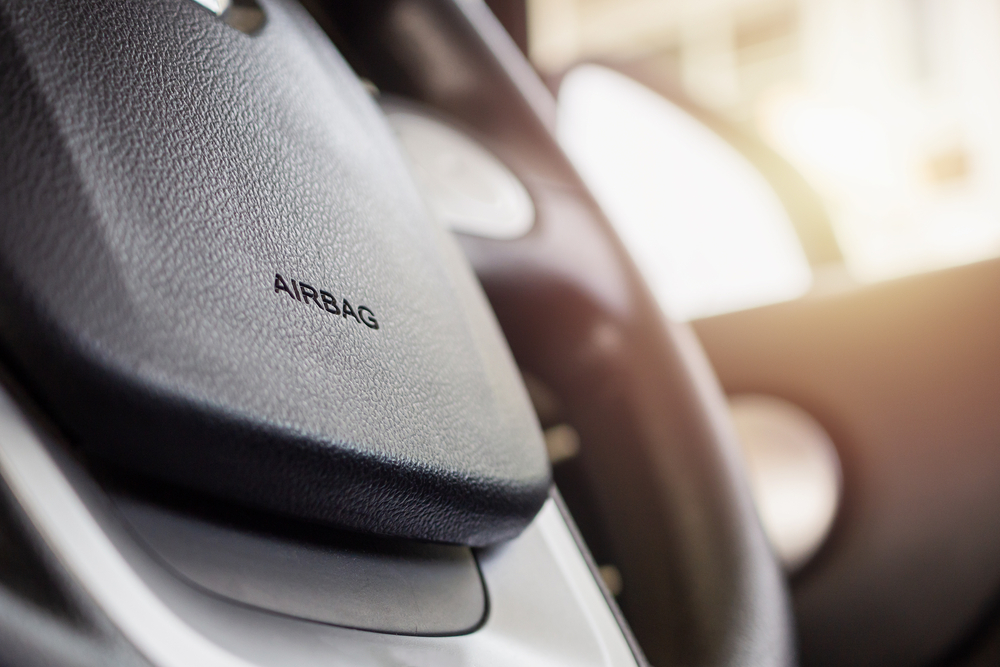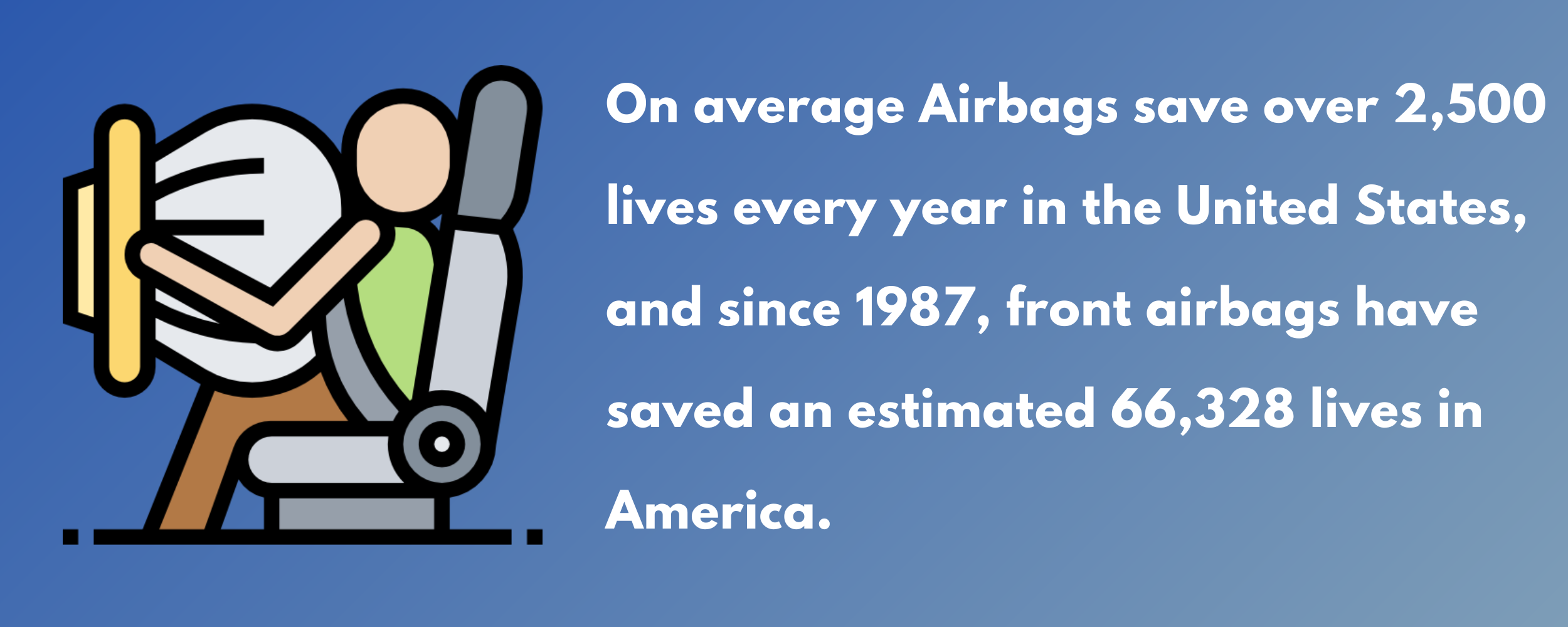
It’s hard to imagine cars being made without airbags, but they’re a relatively modern invention that we owe, in part, to lax seat belt laws. In 1953, an engineering technician named John Hetrick patented his mouthful of a design: a “safety cushion assembly for automotive vehicles” [1]. He sent sketches over to Chrysler, Ford, and General Motors (GM) to no avail; the technology was put on the back burner until Ralph Nader’s 1965 book “Unsafe at Any Speed” argued that, combined with seatbelts, airbags could save lives
One year later, the National Traffic and Motor Vehicle Act required all new cars to be made with seatbelts—not airbags. However, only about 25% of people used these seatbelts, as no law required them to do so [1]. Enter: airbags, a technology which could, in theory, save lives in car accidents whether or not occupants chose to use their seatbelts.
Below, we’ll explore the implementation of airbags in more depth as well as some eye-opening statistics about these safety features.
Key takeaways:
- On average airbags save over 2,500 lives every year in United States.
- Since 1987, Front airbags have saved about 66,328 lives in America.
- Front airbags reduce driver deaths by 29% and front-seat passenger deaths by 32% [5]
- When wearing a lap-and-shoulder seatbelt, airbags reduce the risk of death in frontal crashes by 61% [6]
- Side airbags reduce the driver’s risk of death by 37% in driver-side car crashes and 52% in driver-side SUV crashes [6]
- There is a 50% survival rate when wearing seatbelts alone, whereas the risk of death is reduced by 34% for airbags alone [6]
- As per the latest estimates, 98.40% of passenger and commercial vehicles in America have airbags. Most vehicles without airbags are pre-2000 models.
- Frontal airbags inflate in less than 1/20th of a second, or about 200 mph [3, 11]
- Over 290 deaths were caused by frontal airbags that were deployed in low-speed crashes from 1990-2008 [6]
- From 1996-2000, specifically, airbags killed 116 children and 75 adults [12]
- The National Highway Traffic Safety Administration recalled 67 million airbags from more than 42 million vehicles in 2015’s Takata recall [6, 10]
- The airbag inflator market is worth about $4.33 billion and is expected to be valued at $6.74 billion by 2028 [7]
- On an average, modern airbags deploy at 1/20th of a second or about a speed of 200 mph for 12 to 20 inches.

When did airbags become mandatory?
In the 1970s, automakers Ford and GM began installing airbags in some of their cars [1]. However, there were questions about their safety, namely whether they could cause severe injury or death when deployed on children or smaller adults. But as technology improved, so, too, did airbags, and they were not only widely adopted in 1987 [4] but also became a common feature in cars by the time The Intermodal Surface Transportation Efficiency Act of 1991 was passed, which required all cars and light trucks sold in the US to have airbags on both sides of the front seat. This law officially went into effect on September 1, 1997 for cars and exactly one year later for trucks [1]. By 2014, all cars were required to also include side airbags [6]
How many lives have airbags saved?
Frontal airbags have saved an estimated 50,457 lives between 1987 when they were first widely installed and 2017 [3]. In 2017 alone, front airbags saved an estimated 2,790 lives [3].

What’s more, front airbags reduce driver deaths by 29% and front-seat passenger (13 and older) deaths by 32% [5]. Side airbags, on the other hand, reduce the driver’s risk of death by 37% in driver-side car crashes and 52% in driver-side SUV crashes [6].
Experts also note that airbags alone are not the answer; rather, they are designed to work together with seatbelts, not in place of them. According to NHTSA estimates, when car occupants are wearing a lap-and-shoulder seatbelt, airbags reduce the risk of death in frontal crashes by 61% [6]. Vehicle occupants have about a 50% survival rate when wearing seatbelts alone, whereas the risk of death is reduced by 34% for airbags alone [6].
How do airbags work?
Airbags protect an occupant’s head and upper body from hitting the car’s interior. They are designed to deploy in “moderate-to-severe” crashes, so not every accident will result in the inflation of airbags [4]. When one of these more serious crashes occurs, the airbag system sends a signal to ignite a chemical reaction which inflates the airbag with a harmless gas in less than 1/20th of a second, or about 200 mph [3, 11].
What about side airbags?
As the car door provides less space between passengers and the object being hit in a side collision (another car, tree, etc.), side airbags can inflate even quicker but with less power, thereby causing less serious injuries [6]. In fact, a study of children ages 15 and younger found no increased risk of injury in side crashes due to side airbag deployment. [6].
How do airbags cause injuries?
Serious injury or death can occur when occupants are too close to the airbag as it deploys, which is why car seats and children under 13 years old should always be in the backseat [3]. This is also why it is recommended to sit as far back from the dashboard or steering wheel as possible to sit and drive comfortably [3].
What kinds of injuries are caused by airbags?
Of course, airbags can only save lives when properly functioning. While not common, airbags, like anything, can malfunction. This is typically the result of airbags failing to deploy, deploying unnecessarily, deploying too late, having only one airbag deploy, or having defective parts [5].
Below are the most common injuries caused by malfunctioning airbags [5]:
- Asthma attacks
- Chest injuries
- Concussion
- Eye injuries
- Facial burns
- Fractures, broken bones, and soft tissue injuries
- Hearing loss and tinnitus
- Heart and lung damage
- Lung irritation
- Scarring
- Skin removal
- Severe cuts and abrasions
- Suffocation
- Trauma (head, neck, shoulder, chest, wrist)
- Traumatic brain injuries
Airbag deaths are minimal
Airbags have also been responsible for a number of deaths over the years: more than 290 deaths were caused by frontal airbags that were deployed in low-speed crashes from 1990-2008 [6]. About 90% of those deaths occurred in vehicles that were manufactured before 1998, with more than 80% of those killed either not wearing seatbelts or wearing seatbelts improperly [6]. Even more troubling: the majority of these deaths were passengers, with 90% of those being children and infants [6].
From 1996-2000, specifically, airbags killed 116 children and 75 adults [12]. As previously noted, front airbags, in particular, are risky for those of smaller stature as well as anyone sitting too close to the dashboard. This is why it is crucial for children to sit in the back seat, rather than the front seat.
While there has historically been concern over whether airbags cause more harm than good, a brief look at these numbers would prove this not to be the case. Unfortunately, there have been just shy of 300 deaths caused by frontal airbags from 1990-2008; however, there have been thousands of lives saved as well. It is important to follow safety guidelines such as keeping child car seats in the back, properly wearing seatbelts, and more.
Airbag recalls
Thankfully, when airbags are found to malfunction, the NHTSA steps in and issues a recall. These recalled airbags must be replaced in order to prevent death or injuries such as the above. Consumers can view the NHTSA recall database to view recalls and find authorized repair centers.
One of the most notable of these recalls was the Takata airbag recall. With long-term exposure to high temperatures and humidity, these airbags were capable of exploding when deployed, causing over 400 serious injuries and 24 deaths in the US to date [10]. The recall began in 2015 and, as it impacted about 70 million airbags installed in more than 42 million vehicles made by 34 different brands, it is considered the largest safety recall in US history [6, 10].
Airbag manufacturers
Vehicle manufacturers have a responsibility to produce safe cars. Having saved thousands of lives since they were first introduced, airbags are an essential safety feature today, which is why there are many airbag manufacturers out there. In fact, the airbag inflator market was valued at $4.33 billion in 2021 and is expected to be valued at $6.74 billion by 2028 [7]. Three of the top airbag manufacturers are detailed below:
1) Autoliv
Founded in 1997, Autoliv is one of the oldest safety systems manufacturers in the world. This Swedish-American company has plants in 27 countries [7].
2) Joyson
Formerly Key Safety Systems, Joy Safety System is an American-based company founded in 1986 with a presence in 25 countries [7].
3) ZF Friedrichshafen
Founded in 1915, the German-based ZF has more than 100 years of experience in manufacturing and aims to improve safe mobility while protecting the environment and reducing emissions [8].
Closing thoughts
Thanks to the above airbag manufacturers keeping vehicles safely equipped with airbags, more than 50,000 lives have been saved since the late ‘80s. Both front and side airbags work together to significantly reduce the risk of death in car accidents. This, of course, depends on occupants wearing their seatbelts as well, but it’s clear that, in combination, seatbelts and airbags are some of the most important safety features in vehicles today.
Sources:
- History
- New York Times
- National Highway Traffic Safety Administration
- National Highway Traffic Safety Administration
- Rosenfeld Injury Lawyers
- Insurance Institute for Highway Safety
- Fortune Business Insights
- Expert Market Research
- National Highway Traffic Safety Administration
- Consumer Reports
- Cars Direct
- New York Times
